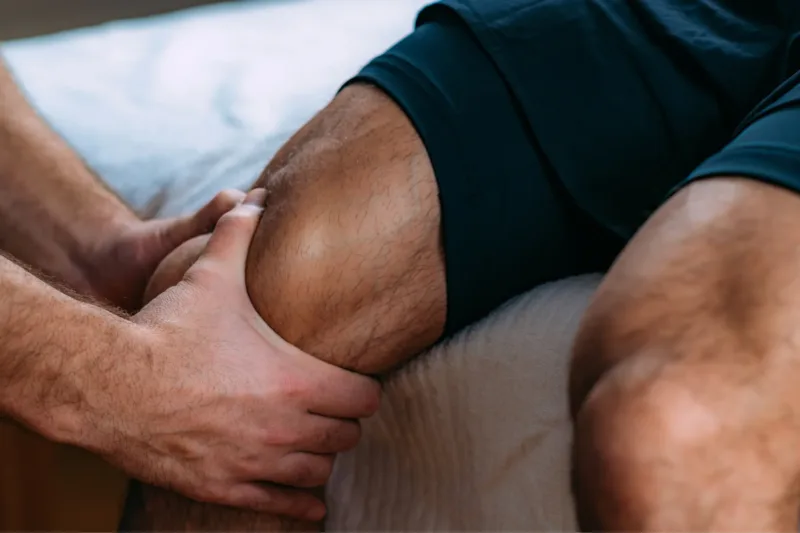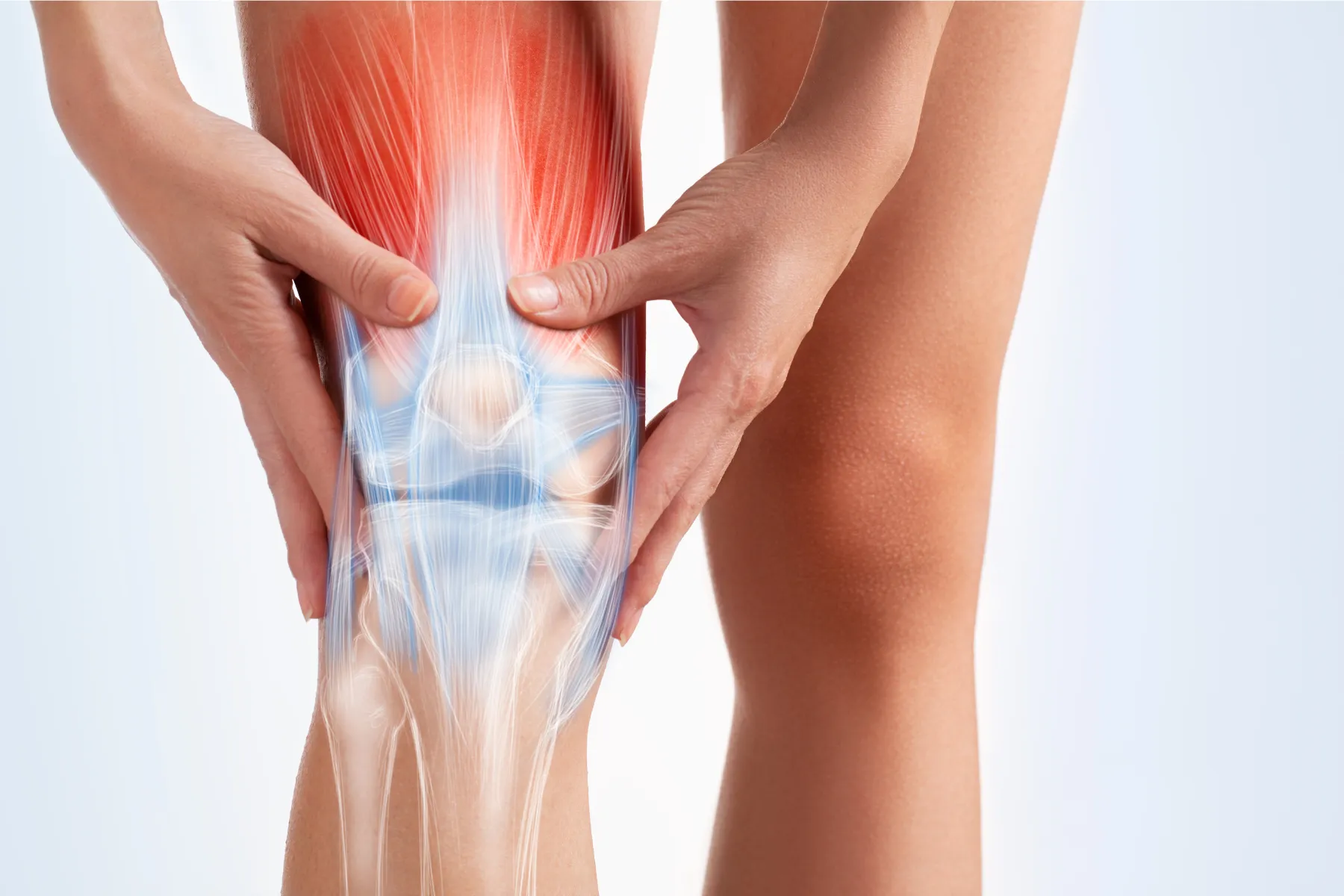
Knee Osteoarthritis
- Knee Osteoarthritis
- What is Knee Osteoarthritis?
- How Does the Knee Work?
- Causes and Risk Factors of Knee Osteoarthritis
- Symptoms of Knee Osteoarthritis
- Diagnosis of Knee Osteoarthritis
- Treatment Options for Knee Osteoarthritis
- Living with Knee Osteoarthritis
- When to Seek Help
- Take the First Step Toward Relief
- FAQs
What is Knee Osteoarthritis?
Knee osteoarthritis is common when the cartilage cushioning the knee joint gradually breaks down. This wear-and-tear condition leads to pain, stiffness, and reduced mobility, impacting daily activities such as walking, climbing stairs, or standing for extended periods. Osteoarthritis primarily affects individuals over the age of 50 but can occur earlier due to injury, overuse, or genetic predisposition.
How Does the Knee Work?
The knee is a complex joint made up of:
- Femur (thigh bone)
- Tibia (shin bone)
- Patella (kneecap)
- Articular cartilage that cushions the bones and helps them glide smoothly during movement
- Synovial fluid, which lubricates the joint
In a healthy knee, these components work together to provide smooth, pain-free motion. In osteoarthritis, the cartilage wears away, causing the bones to rub against each other, leading to inflammation and discomfort.
Causes and Risk Factors of Knee Osteoarthritis
Several factors can contribute to the development of knee osteoarthritis, including:
- Age: The risk increases with age.
- Weight: Excess body weight puts additional stress on the knee joint.
- Injury: Previous knee injuries, such as ligament tears or fractures, can increase the likelihood of developing OA.
- Repetitive stress: Activities or jobs that place repeated strain on the knees.
- Genetics: A family history of osteoarthritis.
- Gender: Women are more likely to develop knee osteoarthritis than men, particularly after age 50.
Symptoms of Knee Osteoarthritis
Common symptoms include:
- Pain during or after activity
- Stiffness, especially in the morning or after sitting for long periods
- Swelling around the knee joint
- Reduced range of motion
- A grinding or clicking sensation during movement
- Weakness or instability in the knee
If left untreated, symptoms can worsen over time, significantly impacting the quality of life.
Diagnosis of Knee Osteoarthritis
To diagnose knee osteoarthritis, a healthcare provider may:
- Review your medical history and symptoms.
- Perform a physical examination to assess joint movement, pain, and swelling.
- Order imaging tests, such as X-rays or MRIs, to evaluate cartilage loss and joint damage.
Treatment Options for Knee Osteoarthritis
Treatment for knee osteoarthritis focuses on relieving pain, improving joint function, and slowing disease progression. Options include:
Non-Surgical Treatments:
- Medications: Over-the-counter pain relievers like acetaminophen or NSAIDs (e.g., ibuprofen) to reduce pain and inflammation.
- Physical Therapy: Exercises to strengthen the muscles around the knee and improve flexibility.
- Weight Management: Losing weight to reduce stress on the knee joint.
- Bracing: Knee braces provide support and stability.
- Injections:
- Corticosteroids to reduce inflammation.
- Hyaluronic acid to improve lubrication in the joint.
Surgical Treatments:
When non-surgical treatments are no longer effective, surgery may be considered, including:
- Arthroscopy: Minimally invasive surgery to remove loose cartilage or repair damage.
- Osteotomy: Repositioning the bones to relieve pressure on the knee joint.
Total Knee Replacement or Partial Knee Replacement: Replacing the damaged joint with a prosthesis.
Living with Knee Osteoarthritis
Managing knee osteoarthritis requires a combination of treatments and lifestyle changes. Tips include:
- Staying active with low-impact exercises such as swimming or cycling.
- Using assistive devices like canes to reduce strain.
- Practicing good posture and body mechanics to protect the joints.
When to Seek Help
If knee pain or stiffness is interfering with your daily life, it’s time to seek professional care. Early diagnosis and treatment can help slow the progression of osteoarthritis and improve your quality of life.
Take the First Step Toward Relief
Don’t let knee osteoarthritis hold you back. Contact Louisville Hip & Knee Institute today to schedule an appointment and learn more about how we can help.
FAQs
Can knee osteoarthritis be prevented?
While knee osteoarthritis cannot always be prevented, maintaining a healthy weight, avoiding excessive strain on the knees, and staying active with low-impact exercises can help reduce the risk. Early intervention when symptoms appear can also slow progression.
What is the best exercise for knee osteoarthritis?
Low-impact exercises such as swimming, cycling, and walking can help maintain joint flexibility and strengthen muscles around the knee without putting excess stress on the joint. Your doctor or physical therapist may recommend specific exercises tailored to your needs.
How long does it take for knee osteoarthritis to progress?
The progression of knee osteoarthritis varies by individual. Factors like age, weight, activity level, and the extent of cartilage damage play a role. Early treatment can effectively manage symptoms, and progression may slow significantly. Regular monitoring with your healthcare provider is important for managing the condition.
Is knee surgery always necessary for osteoarthritis?
Surgery is not always required for knee osteoarthritis. Many individuals manage the condition with non-surgical treatments such as medication, physical therapy, weight management, and injections. Surgery is typically considered when conservative treatments no longer provide sufficient relief.
What is the recovery time after knee surgery for osteoarthritis?
Recovery time depends on the type of surgery performed. Minimally invasive procedures like arthroscopy may have a quicker recovery time, while more extensive surgeries, such as total knee replacement, can take several months for full recovery. Your doctor will provide guidance on what to expect based on your specific surgery.
Can knee osteoarthritis affect my ability to work?
Knee osteoarthritis can impact daily activities, including work, especially if your job requires long periods of standing, walking, or lifting. Adjustments like using assistive devices or modifying your workspace may help manage symptoms. If work activities cause discomfort, speaking with your doctor about possible treatments or accommodations may be beneficial.



